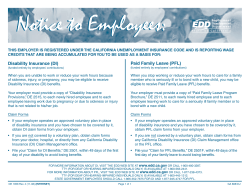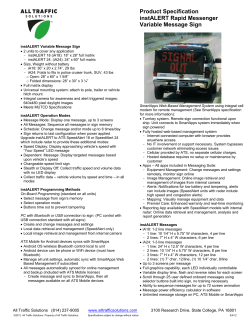
Quality Systems in the Pulmonary Function Laboratory
Quality Systems in the Pulmonary Function Laboratory Carl Mottram, BA RRT RPFT FAARC Director - Pulmonary Function Labs & Rehabilitation Associate Professor of Medicine - Mayo Clinic College of Medicine Case Presentation • 31 y.o. female • History of present illness • Non-specific cough, tightness in throat and episodic shortness of breath following URI • No wheezing noted by patient or on exam • Exam normal other than obesity (BMI 38) • LMD orders CXR and spirometry with diffusing capacity Case Presentation • CXR • Spirometry & DLCO Pre External Pulmonary Laboratory 12 Control Post Albuterol Predicted 10 Post %Pred FVC 2.10 2.11 62% FEV1 0.89 1.36 31% Flow L/s 8 6 4 2 Ratio 42.4 DLCO 64.5 8.0 30% 0 0 1 2 3 4 5 6 Volume L Impression: Severe obstruction with a severe reduction in DLCO. Some improvement with BD 7 8 Case Presentation • LMD Action Plan • Orders a CT scan • Referred to Mayo Clinic for further evaluation Case Presentation • Outside CT negative • Pulmonary, ENT, and GI consults scheduled • Pulmonary physician • Negative exam • Lungs clear, patient had coughing spell during exam, no wheezing or stridor noted • Questioned outside spirometry results and orders PFT’s Case Presentation Mayo Pulmonary Function Laboratory • Spirometry & DLCO 12 Control Post Albuterol Predicted 10 Pre Post %Pred 2.55 2.48 75% FEV1 2.27 2.25 79% Ratio 89 90.7 Flow L/s FVC 8 6 4 2 0 DLCO 24.2 99% 0 1 2 3 4 5 6 7 8 Volume L Impression: Borderline restriction most likely 2 to obesity with no evidence of airflow obstruction or BD response PFT results affect people!!! • Further testing • Labeling (COPD, Asthma, etc) • Medicine • Disability Guidelines and Standards • American Thoracic Society •1987 Revised Spirometry Standards •1991 Reference Values & Interpretation •1994 Revised Spirometry Standards •1995 Diffusing Capacity • 1999 Guidelines for Methacholine and Exercise Challenge Testing •ATS/ERS 2005 Series; General Laboratory, Spirometry, Diffusing Capacity, Lung volumes, and Interpretation Guidelines and Standards • American Association of Respiratory Care (AARC) • Clinical Practice Guidelines (52) • Spirometry • Static lung volumes • Plethysmography • Diffusing Capacity • Infant/Toddler Pulmonary Function Tests Guidelines and Standards • American Thoracic Society • ATS Pulmonary Function Laboratory Management and Procedure Manual • Updated 2005 • www.thoracic.org • Education • Education Products CLSI’s Quality System In Respiratory Care – HS4-A2 Patient Patient assessment Path of workflow QSE Clinical interpretation application Evidence of Quality Testing • Spirometry in Primary Care Practice* • 30 primary care clinics, 15 trained group /15 usual group • 3.4% in usual group and 13.5% in trained group met ATS acceptability and reproducibility criteria • 1,012 pt. tests, 2,928 blows (2.89) • * Eaton et al, Chest 1999; 116:416-423 Evidence of Quality Testing • Improving the Quality of Bedside Spirometry • Audit of testing outside the PF lab Cleveland Clinic • 15% - ATS acceptability/reproducibility criteria • CI Project - 63.5% acceptability/reproducibility • Stoller JK. Orens DK. Hoisington E. McCarthy K. Bedside spirometry in a tertiary care hospital: The Cleveland Clinic experience. Respiratory Care. 47(5):578-82, 2002 May Evidence of Quality Testing • Wanger J, Irvin C Resp Care 36 (12): 1991 • 13 hospitals, 7 different systems, 5 Bio-QC (3 men, 2 women) • DLCO CV 11.5 - 18.6 with the largest diff. 24 units Evidence of Quality Testing Certification of DLCO Measurements for Clinical Trials • Results of the initial DLco simulation tests from 125 pulmonary laboratories • 94 (75.2%) Passed with coaching; no hardware • 24 (19.2%) Failed. Passed after servicing • 6 (4.8%) Failed. Passed with new equipment • 1 (0.8%) Site dropped 1 R.L. Jensen, PhD., R.O. Crapo, M.D., P.Y. Berclaz, M.D., Ph, C. Zimmer, B.S., D.M. ATS abstract 2007 Evidence of Quality Testing Results from a survey of PFT labs in Europe and Latin America Enright, Blonshine, Harris 2007 ERS abstract Quality Systems in the PFL Quality Assurance “Systematic” approach of monitoring and evaluating quality. Quality Systems in the PFL Quality Assurance • CLSI’s “Path of workflow” Model • Pre-test • Testing session • Post-test Quality Systems in the PFL Pre-test • Pre-test instructions • Appropriate order • Questionnaire • Height* and weight • Networked systems • Equipment quality assurance program Quality Systems in the PFL Pre-test • Subject preparation • Activities that should preferably be avoided prior to lung function testing. • Smoking within 1 hours of testing • Consuming alcohol within 4 hours of testing • Performing vigorous exercise within 30 • minutes of testing Wearing clothing that substantially restricts full chest and abdominal expansion Eating a large meal within 2 hours of testing • • Deviations recorded 2005 ATS/ERS Standards General Laboratory Quality Systems in the PFL Pre-test • Height and weight •Measured in indoor clothes without shoes •Patients with deformities of the thoracic cage should have their arm span measured •Regression equations •Ht = arm span/1.06 2005 ATS/ERS Standards General Laboratory Quality Systems in the PFL Pre-test • Equipment quality assurance •Validation/Verification •Preventive maintenance •Documentation and records (logbooks) • Mechanical models • Biological models Quality Systems in the PFL Pre-test • Mechanical Model •3-liter syringe • 0.5, 1-2, 6 second flows •Leak checked •Stored and used in such a way as to maintain the same temperature and humidity of the testing site •Validated based on manufacturer 2005 ATS/ERS Standards recommendations Standardization of Spirometry Quality Systems in the PFL Pre-test Mechanical Model Plethysmography • Validation using a known volume should be performed periodically • Model lung with thermal mass to simulate isothermal conditions of the lung. • Accuracy 50 ml or 3% 2005 ATS/ERS Standards Standardization of Lung Volumes Quality Systems in the PFL Pre-test • Mechanical Model – Dilution techniques • Analyzer accuracy and linearity • N2 washout: Monthly, exhalation volumes should be checked with the syringe filled with room air, and inhalation volumes with the syringe filled with 100% O2. 2005 ATS/ERS Standards Standardization of Lung Volumes Quality Systems in the PFL Pre-test • Mechanical Models – DLCO • Syringe DLCO weekly or whenever problems occur •VA,VC BTPS ~ 3.2- 3.3L • DLCO Simulator or BioQC 2005 ATS/ERS Standards Standardization of DLCO Quality Systems in the PFL Pre-test • Biological Model • Normal laboratory subjects • Two individuals (13) • Establish mean and SD (minimum 20 samples) 2005 ATS/ERS Standards General Laboratory Quality Systems in the PFL Pre-test Biological Control - Plethysmography • At least monthly or whenever errors are suspect 2 reference subjects (biologic controls) should be tested 2005 ATS/ERS Standards - Standardization of Lung Volumes Quality Systems in the PFL Pre-test Biological Control – N2 washout • At least monthly or whenever errors are suspect 2 reference subjects (biologic controls) should be tested 2005 ATS/ERS Standards - Standardization of Lung Volumes Quality Systems in the PFL Pre-test Biologic Control – He dilution • At least monthly or whenever errors are suspect 2 reference subjects (biologic controls) should be tested 2005 ATS/ERS Standards - Standardization of Lung Volumes Quality Systems in the PFL Pre-test Biologic Control – Diffusing Capacity • At least weekly • Or whenever errors are suspect • Or whenever a calibration tank is replaced DLCO and VA from Diffusing Capacity BioQC Technologist #3 25 DLCO Units/Liters 20 15 DLCO VA 10 5 0 1 5 9 13 17 21 25 29 33 37 41 45 49 53 57 61 65 69 73 77 81 85 89 93 97 101 105 109 113 117 Measurement Number 2005 ATS/ERS Standards - Standardization of DLCO Quality Systems in the PFL Biological Quality Control - PF Lab • Results “Out of range” Repeat with another technologist Second tech is within limits - record out of range data Second tech out of range - trouble-shoot and document BioQC1: FEV1 FVC TLC (Pleth) DLCO ULN 2.95 3.62 6.09 24.5 LLN 2.73 3.35 5.65 21.5 SD 0.05 0.07 0.11 0.75 CV 0.02 0.02 0.02 0.04 Quality Systems in the PFL Biological Quality Control - DLCO Bio QC Technologist Comparison 35.00 30.00 25.00 20.00 15.00 10.00 5.00 0.00 1 2 3 4 5 6 7 Model A versus B: Mean difference 0.5 8 9 Quality Systems in the PFL Subject comparisons: DLCO 35 30 25 20 15 10 5 ie n tK tJ Pa t ie n tI Pa t ie n tH Pa t ie n tG Pa t ie n Pa t ie n tF tE Pa t ie n tD Pa t ie n Pa t ie n tC tB Pa t ie n Pa t Pa t ie n tA 0 Model A versus B - Mean difference 1.5 12 10 8 Abnormal Study: Mild airway obstruction with a significant response to bronchodilator. Lung volumes suggest hyperinflation. DLCO is within normal limits. Flow, L/s 6 4 2 0 0 1 2 3 4 Volume, L 5 6 7 8 Predicted Control Post Dilator Date 4/12/2008 3/12/2008 2/12/2008 1/12/2008 12/12/2007 11/12/2007 10/12/2007 9/12/2007 8/12/2007 7/12/2007 6/12/2007 5/12/2007 4/12/2007 3/12/2007 2/12/2007 1/12/2007 12/12/2006 11/12/2006 10/12/2006 9/12/2006 8/12/2006 7/12/2006 6/12/2006 5/12/2006 4/12/2006 3/12/2006 2/12/2006 1/12/2006 12/12/2005 11/12/2005 10/12/2005 TLC - He Liters Quality Counts BioQC Anderson 10 Test performed 9 8 Changed Sodasorb 7 6 5 BioQC data -2 SD +2 SD 4 3 2 1 0 “This is fine as far as it goes. From here on, it’s who you know.” Quality Systems in the PFL Test • Testing room environment • Environmental interference • Technologist’s performance & training - QSE: Personnel • Second technologist • Meeting ATS/ERS acceptability and repeatability criteria (new guidelines) Quality Systems in the PFL Test - QSE: Personnel • Technologists • Job qualifications • Job descriptions • Orientation • Training • Competency assessment • Continuing education • Performance appraisal Quality Systems in the PFL Test - QSE: Personnel • Competence Assessment • Training and on-going performance evaluations • NIOSH Spirometry Training Course • cdc.gov/NIOSH/topics/spirometry • AARC’s Spirometry Training • National Board for Respiratory Care • CPFT and RPFT exams ATS/ERS Standards Standardization of Spirometry Between Maneuver Evaluation • Minimum of 3 maneuvers • Acceptable repeatability is achieved when the difference between the largest and the next largest FVC is 0.150 L or less AND the difference between the largest and next largest FEV1 is 0.150 L or less. • For those with an FVC of 1.0 L or less both these values are 0.100 L. ATS/ERS Standards Standardization of DLCO • Should be at least two acceptable tests that meet the repeatability criteria: •Within 3 mL/min/mmHg-1 (or 1 mmol/min/kPa) of each other •or within 10% of the highest value. • Report average of at least two acceptable tests ATS/ERS Standards Standardization of Lung Volumes Measurement technique - Plethysmography • Quiet breathing until a stable end-expiratory level is achieved • Close shutter at or near FRC • Approx 2-3 seconds • Gentle pants + 10 cmH2O • 0.5 to 1 Hz (30-60 breaths per minute) • > 1.5 Hz may lead to errors • < 0.5 Hz may cause problems with the controlled leak ATS/ERS Standards Standardization of Lung Volumes Measurement technique – Plethysmography (cont) • 3-5 technically satisfactory panting maneuvers • Patient then performs an ERV maneuver followed by a slow IVC (preferred method) • “Linked” maneuvers ATS/ERS Standards Standardization of Lung Volumes A. Shutter closure B. A. Preferred method B. Secondary preferred method Shutter Shutter closure closure ATS/ERS Standards Standardization of Lung Volumes • Alternative method Shutter closure •Patient then performs an IC followed by a slow exp. VC Shutter closure Pant prior to shutter closure Target: < 200 mls switch-in error ATS/ERS Standards Standardization of Lung Volumes Reporting (Preferred method) • Repeatability: Obtain > 3 FRCpleth values that agree within 5% • Largest FRC – smallest FRC mean FRC • Reported FRC is the mean of the technically satisfactory measurements linked to the technically satisfactory ERV and IVC maneuvers used for calculating RV and TLC. • Reported TLC is the reported value for RV plus the largest of the technically acceptable IVC’s ATS/ERS Consensus Statements Summary Quality Systems in the PFL Test Quality Assurance • Lung volumes - DLCO VA 500 ml larger than TLC - ??? • Technologist Driven Protocols • Reference equations • NHANES III Quality Systems in the PFL Test Quality Assurance Technologist Driven Protocol For Complete Pulmonary Function Testing with Bronchodilator • Technologist Driven Protocols 2: Abnormal Flow, Volume, or MD requested TLC SPIROMETRY 1: Abnormal MVV FVC, FEV1, FEV%, MVV TLC Normal Spirometry Give Bronchodilator MVV < FEV1 x 30 Skip if restrictive pattern with previous documentation of no response to Rx No No Normal TLC Low FEV1 or FVC Normal FEV1% Yes • Flowcharting the Yes DLCO Neuromuscular Disease No Upper Airway Yes process Yes Airway Resistance No Abnormal VA Yes Resting OXIMETRY TLC No Technologist Discretion Maximal Respiratory Pressures (if neuromuscular diagnosis) and / or FIVC Maneuvers All tests are normal with no hx of pulm. vascular disease Resting SpO2 < 88% on room air or oxygen No Yes No Exercise OXIMETRY Yes SpO2 < 80% or patient is intolerant to testing Yes PATIENT ASSESSMENT Did the patient comply with pretest instructions? Prior to testing a patient with suspected room air hypoxemia place pulse oximeter. If resting SpO2 < 80 on room air perform spirometry on oxygen (if prescribed) and cancel lung volumes and DLCO Report room air SpO2, do not exercise Terminate Testing Call MD if resting SpO2 < 88% or exercise SpO2 < 85% to recommend ABG's No No >4% Fall in SPO2 & Normal Resting Saturation & Normal PF Yes Post BD FVC's PF TESTING COMPLETE Repeat Oximetry Quality Systems in the PFL Post-Test Quality Assurance • Maneuver selection • Quality review by second technologist • “While in-house training may achieve the desired goals, laboratory directors should strongly consider the benefits of formal training programs from outside providers.” • Feedback to the technicians concerning their performance should be provided on a routine basis 2005 ATS/ERS Standards General Laboratory Technician Training and Feedback Improve Test Quality 4.0 Volume grade 3.5 Flow grade GPA 3.0 Quality control feedback started 2.5 Site visits and training update 2.0 1 2 3 4 5 Year Lung Health Study Enright: Am Rev Respir Dis 143:1215, 1991 6 7 Quality Systems in the PFL Post-Test Quality Assurance • Turn-around time • Average TRT: <1 day (15%), 1-2 d (30%), 3-4 d (27%), 5-6 d (15%), >7 d (3%) • ATS PFL Registry Abstract AARC 2005, OF-05-037 • Electronic Medical Record Quality Systems in the PFL Does it Work? • Retrospective review of 18,000 consecutive pts. at Mayo Clinic • Ninety percent of the patients were able to reproduce FEV1 within 120 ml (6.1%), FVC within 150 ml (5.3%), and PEF within 0.80 L (12%). American Journal of Respiratory & Critical Care Medicine. 169(2):235-8, 2004 Jan 15. Evidence of Quality Testing • Quality Control in Spirometry in the Elderly* • 984 controls, 638 COPD pts. • 95.8% repeatable tests in controls, 87.6% in COPD • 4.8 + 1.7 tests per session • * Bellia et al, AJRCCM 2000; 161:1094-1100 Evidence of Quality Testing • Quality of Spirometry Test Performance in Children and Adolescents** • 4,000 public school students 9-18 yrs. • 95% of the tests met adult-based ATS standards • ** Enright et al, Chest 2000; 118:665-671
© Copyright 2025









